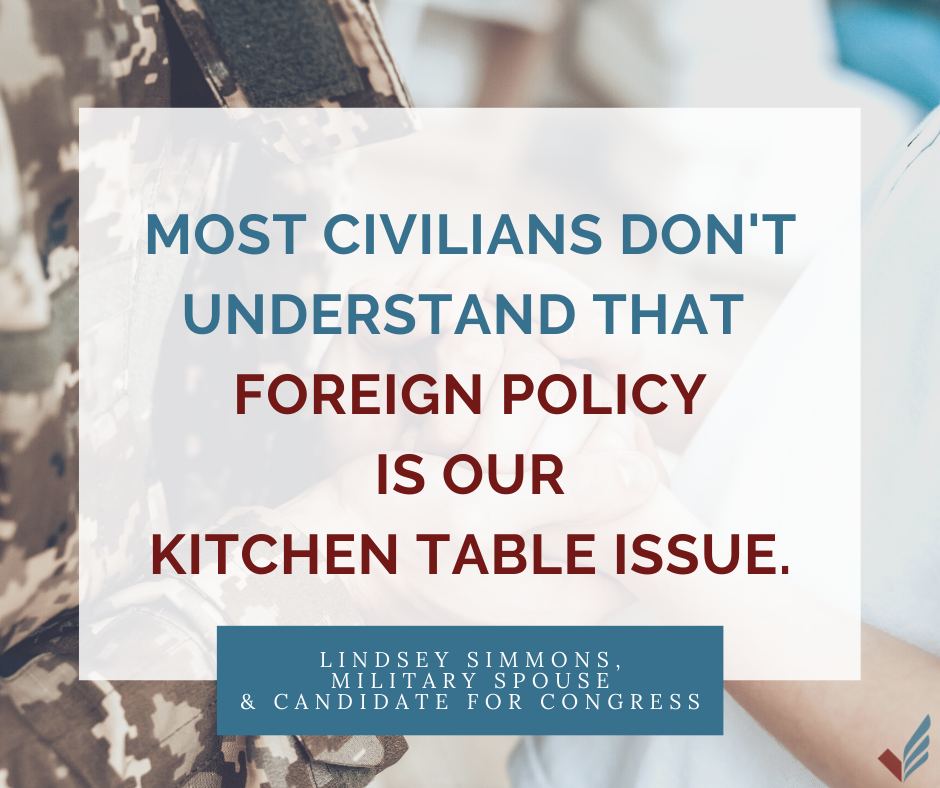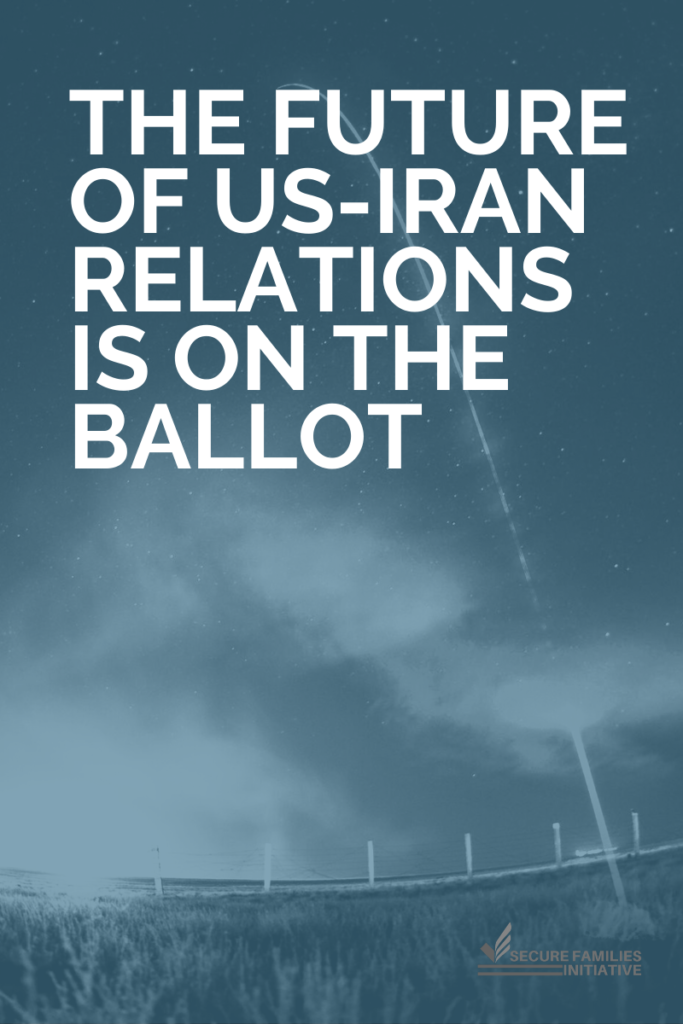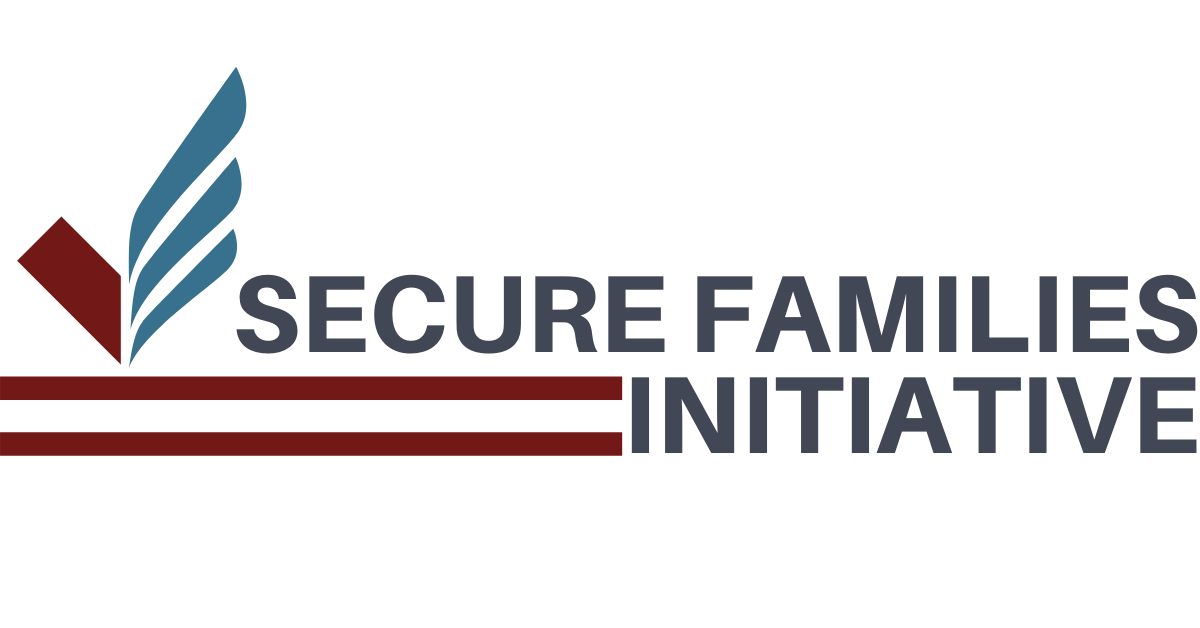I know. 2020 has been the longest year in human history. What I’m about to say will sound like I’m talking about a lifetime ago, but bear with me…
Remember January?
Remember when the United States came to the brink of war with Iran? Remember the news alerts on our phones about far-away military strikes, and the hours that turned into days of uncertainty about what they were going to do next?
I do. And I don’t want to feel that way again.
To quote a fellow military spouse, Lindsey Simmons: “Foreign policy is our kitchen table issue.” High-level decisions over how the U.S. engages with the world hit close to home for military families like ours. Because they impact everything — from how often we have to move, to whether our loved ones will be put in harm’s way.

Our community of military families only makes up about 1% of the U.S. population, but the burden of fighting the last 19 years of war has fallen squarely on our few shoulders. The last thing many of us want is yet another conflict to contend with.
This means that we, as voters and advocates for our community, have to pay close attention to the bilateral relationship between the U.S. and Iran, in order to push our policymakers in the best direction for our country and our families.
So let’s take stock of how we got here.
The death of General Qassem Soleimani and subsequent Iranian ballistic missile strikes against bases in Iraq housing U.S. soldiers in January marked a flashpoint in US-Iran relations. Since the end of the Iran-Iraq war, relations between the United States and Iran have been marked by periods of heavy sanctions designed to counter Iranian nuclear proliferation and condemn state-sponsored terrorism in the region.
In 2015, the Obama administration negotiated an agreement between Iran and the P5+1 (China, France, Russia, the United Kingdom, the United States, and Germany) to limit Iran’s nuclear activities. In exchange for sanctions relief, Iran pledged to limit uranium enrichment and allow for international inspections of its facilities.
While reports show the agreement was effective in curbing Iran’s nuclear activities, many politicians opposed the deal, arguing that it did not go far enough to combat Iranian efforts to destabilize the region through its support of militant groups.
In 2018, the Trump administration announced that the United States would withdraw from the Iran nuclear deal, formally known as the Joint Comprehensive Plan of Action (JCPOA), in favor of “maximum pressure” through heavy economic sanctions. As a result, Iran’s economy plummeted, and European nations still honoring the agreement struggled to help international companies avoid U.S. penalties for continuing trade with Iran. The U.S. withdrawal from the deal marked a stark turning point in rising escalations with Iran.
Throughout 2019, the U.S. tightened sanctions and deployed additional troops to the region while Iran resumed uranium enrichment and struck several U.S. targets. A December rocket attack killed a U.S. civilian contractor and wounded several U.S. and Iraq military personnel. The U.S. retaliated by striking five facilities in Iraq and Syria controlled by an Iran-backed Shia militia group, and by New Year’s Eve, hundreds of pro-Iranian demonstrators had stormed the U.S. Embassy in Baghdad.
It is in this context that President Trump ordered the airstrike that killed Iranian General Soleimani, commander of the IRGC-QF, in early January 2020. In a statement, President Trump said, “We took action last night to stop a war. We did not take action to start a war.” He also threatened military action against 52 Iranian sites in case of retaliatory strikes against Americans or U.S. assets.
In the days that followed, military families waited in anguish as Iran fired 16 missiles at bases housing U.S. troops, praying that loved ones were safe and that diplomatic channels would succeed in preventing another U.S. war in the Middle East. Over one hundred service members returned home with Traumatic Brain Injuries (TBIs) from retaliatory strikes.
While the immediate threat of war has receded, diplomatic relations remain tenuous at best. Just last month, the United States failed to reach consensus among key European allies on a UN Security Council vote to extend an arms-related embargo on Iran, which is set to expire in October. As it stands, Iran refuses to negotiate unless the United States fully abides by the JCPOA; meanwhile, the U.S. is doubling down on its max pressure campaign by trying to force a “snapback” of harsher sanctions indefinitely.
It’s time to reevaluate our path moving forward.
The max pressure campaign has done little to curb Iranian military influence in the region, has decreased U.S. diplomatic credibility in the UN, and has pushed Iran closer to obtaining nuclear weapons. Whoever wins the Presidential election this November will be faced with the challenge of repairing diplomatic relations with our allies and an Iran with greater access to weapons that could be used by regional militias in future attacks on bases housing U.S. soldiers overseas.
Certainly, the first step in a 2021 revamp will have to include some steps that can help calm tensions. This could include reentry into the JCPOA, reversing the travel ban on Iran, and/or relaxing some of the most recent sanctions. But so much has changed since 2015 that reverting exactly back to the prior diplomatic state of Iran-US relations will be practically impossible.
Instead, we need to face forward and decide the best approach to avoid another close encounter with war. Smart foreign policy in Iran must prioritize negotiations that prevent Iran from obtaining a nuclear weapon and de-escalate tensions in proxy-conflicts in the Middle East. Those are two related but distinct goals that each require their own strategic partnerships and negotiations.
For the wonks out there who are interested in digging deeper, we suggest these pieces by the Center for a New America Security and the Center for American Progress as excellent policy resources.
But what does that mean for us, now?
Thankfully, there are a number of steps that concerned military partners and family members can take to make this vision a reality.
It starts with voting. This November, we get to elect leaders up and down the ballot who we believe will rightly mobilize all the pillars of our national security, and re-engage productively with Iran.
It also means telling our stories. Have tough conversations with friends and family about how being at war has impacted you, how you felt in January, and why you care so strongly about our foreign policy putting diplomacy before militarization. Write up your story into an opinion article or letter to the editor so your neighbors can see (Questions about how? We can help!). Now’s the time for us to be vocal and visible.
Finally, it means holding whomever we elect accountable to this vision. November 3rd isn’t the day when we get to cast our ballots and then check out. That’s when the real work begins. Get ready to make calls, sign petitions, and recruit other milspouses to do the same.
Co-authored by SFI Director Sarah Streyder and SFI Volunteer Janessa Schilmoeller


